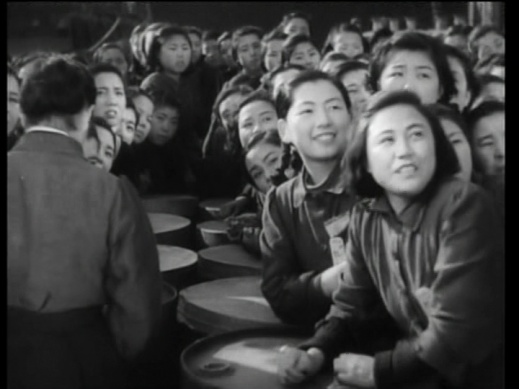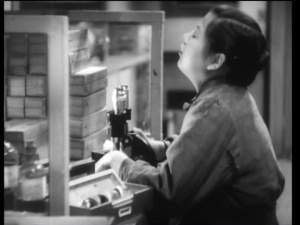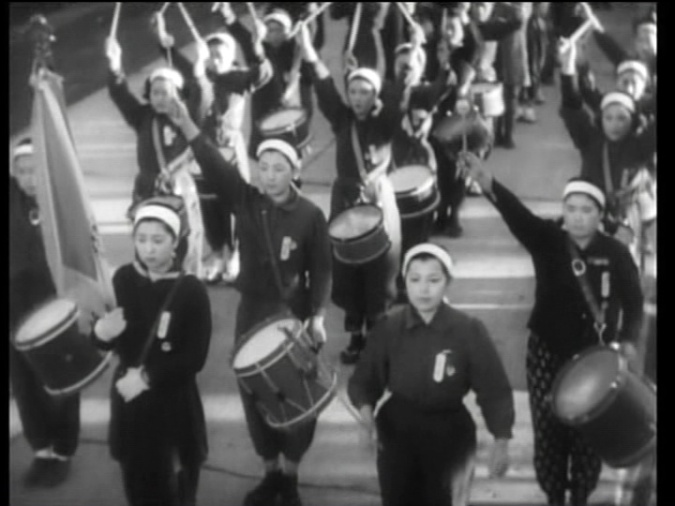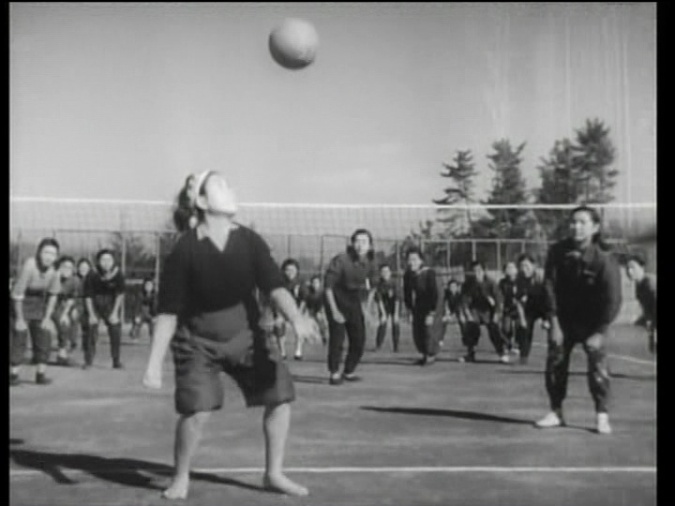
The factory girls admire the bombers flying with their bombsights
A rare surviving propaganda movie from the war years, The Most Beautiful has reached America through Criterion more because it was an early film by Kurosawa than for any particular artistic merit. Like many American and British movies of the same era, it tells the story of the contribution and sacrifices of the girls back home. In a sense, then, it is the story of “Haruko the Riveter,” except that Haruko in this case does not work building planes or munitions. Rather, she is assigned to a factory that produces fine optics such as are used in periscope lenses or bomb sights.
There are some of the crises we would expect from such a movie. One girl is sick and tries to disguise it so she can keep doing her duty. In another, Tsuru (the “president” of the women, more like a dorm mother for them) continues to work even though she hears her mother is dying. A girl who is sent to hospital comes back to work with a cast on her foot. Tsuru spends a lone night personally checking the day’s work of everyone for fear there is a mistake that might lead to losing the war, etc.

Tsuru struggles to find the defective lens
But what is really interesting is all of the standard tropes we would find in American or English films that are not there. First and foremost, they are not just called “girls” but really are girls (except Tsuru and a couple of other leaders), unmarried teenagers recruited from the farms in the provinces, brought long distances to work far from home. The distance is such that each girl has a handful of soil sent from her home village to put in the garden so that the factory can now be her home.
Men other than fathers are rarely mentioned. Since all are unmarried, they of course have no husband serving, but they also have no “boyfriends” left behind, no brothers in the service to whom they write or from whom they receive letters. We don’t have the all but obligatory scene of the wife getting the terrible telegram nor the joy at receiving a letter after agonizing months of silence. Being unmarried, they have no children left behind with grandma while they volunteer. Even though there are men working at the factory as well, no one falls in love and has secret meetings after dark. No one regrets the decision to come to work, and only the sick girl ever gets tired.
All the women sleep in military-style barracks and eat and sleep on a military style regimen. They march to and from their shifts with a fife and drum or singing together. On their rest breaks, they play team sports, such as volleyball.
Everything is teamwork and service, a formula that we have seen in the few surviving war films and which would be later carried over into the unique culture of postwar Japanese corporate life. No real attempt is made to individualize the girls, and even Tsuru is distinguished only by her maturity and by her greater will to serve.
At one point, there is an attempted blow for gender equality of sorts. The factory manager announces an increase in the quotas and the girls band together to object that they did not receive the same increased workload.
Only two scenes hint at the Kurosawa to come. The volleyball match is energetically edited but also full of the low-angle leaps into the clear sky that may remind some of the Nazi and Soviet propaganda films of Our Glorious Youth. The montage of the actual factory work is clean, clear, and pure film school. As a movie, it is more than a little disappointing, since all the melodramatic shorthand of our own wartime films has been abandoned. But as an insight into how the Japanese themselves approached the war effort (or at least how the Japanese government wanted the public to approach the war effort), it is arguably the most valuable film to have survived the war.
Two interesting sidelights: — the Foreman is played by Takashi Shimura, in his second film with Kurosawa and Kurosawa’s second film. He would become Kurosawa’s indispensable performer, appearing in more of his movies than even Mifune. Tsuru is played by Yoko Yaguchi,

Yoko Yaguchi
who seemed headed for a major career that was cut short when, shortly after this film, she married Kurosawa and devoted herself to being a Japanese wife. Unlike so many studio marriages, they were never divorced.


Pingback: Three Women in the North / Kita no san-nin (1945) | Japanonfilm
Pingback: War of the 16 Year Olds / Juroku-sai no senso (1973-76)* | Japanonfilm
Pingback: The Sea is Watching / Umi wa miteita (2002) | Japanonfilm
Pingback: Japan’s War movies (I) | Japanonfilm